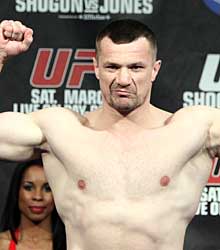Six biggest MMA storylines of 2016
The UFC had a spectacular finish to a very successful year over the closing months of 2015. Holly Holm’s upset victory over Ronda Rousey in front of a record crowd at UFC 193 in Australia was followed by Conor McGregor’s stunning 13-second knockout of Jose Aldo at UFC 194 in December, making for the biggest back-to-back events since the heyday of Brock Lesnar in 2008-09.
So what does the UFC, and the sport of mixed martial arts overall, do for an encore in 2016? Thursday night’s breaking news of a UFC 197 megacard featuring lightweight champion Rafael dos Anjos vs. featherweight champ Conor McGregor and women’s bantamweight champion Holly Holm vs. Miesha Tate was the tumble of a major domino setting the events of the year in motion.

Conor McGregor chases history
Speculation ran wild after McGregor’s victory over Aldo: Would he stay at 145? Would he go up to 155? The answer, as was revealed this week, was both. McGregor will attempt to become the first simultaneous, two weight-class champion in UFC history when he meets dos Anjos on March 5 in Las Vegas. The last fighter to attempt this, then-lightweight champion B.J. Penn, lost to then-welterweight champion Georges St-Pierre at UFC 94 in January 2009.
To date, the only fighter in MMA history to hold simultaneous championships that were considered to have credible “world title” claims was Dan Henderson, who held PRIDE’s 183- and 205-pound titles in 2007. The short-term loser due to the McGregor-dos Anjos bout is top featherweight contender Frankie Edgar, who will have to wait and see what happens in the UFC 197 fight before finding out his fate.
What’s next for Ronda Rousey?
There were a pair of developments worth noting this week in the aftermath of Rousey’s memorable knockout loss to Holm: The first is that Holm, the new women’s bantamweight champ, has signed a new contract with the UFC, and will defend her title against Tate rather than wait for Rousey’s return to the Octagon. The second was the announcement that Rousey will host “Saturday Night Live” on Jan. 23, an indication her star power has not waned in the wake of her loss.
So when will Rousey, who has still yet to get cleared for contact drills following her loss, return to action? When she does, will she go straight back to a title shot or take a tune-up fight in the interim? And is the SNL gig an indication she’s considering not returning to MMA at all? Until she speaks, the conjecture will continue unabated. Meanwhile, the announcement of Holm vs. Tate, of course, leads to the potential of Tate winning and gumming up the works for Holm-Rousey 2, but even that has a silver lining: a third fight between Tate and Rousey, with the new wrinkle of Tate holding the championship, is also a sellable potential return fight for Rousey.
Can Jon Jones regain his throne?
This time last year, the debate raged on whether Jones had earned the title of greatest MMA fighter of all time. He had just turned away his toughest challenger, Daniel Cormier, at UFC 182, which raised his record to 21-1 (the only “loss” on the record being a terrible disqualification call against Matt Hamill in 2009). In the year since, Jones was stripped of his title, which was subsequently won by Cormier, after an April incident in New Mexico in which he left the scene of a car accident.
After getting probation in the case, Jones, 28, was cleared to return, and is expected to meet Cormier for the title on April 23, with Anaheim, Calif., as the likely location. Will ring rust be an issue for Jones after the longest break of his career? And can he abide by the strict terms of his probation? So far, the answer to the latter has been positive. We’ll have to wait until April to find out the former.
How real is MMA free agency?
The business changed on the night of Nov. 15, 2014. That’s when a pair of former retirees, Tito Ortiz and Stephan Bonnar, drew a monster rating for Bellator and Spike TV and changed the game. Spike/Bellator owner Viacom has proven it'll spend money to make a splash, including signing free agents Phil Davis and Josh Thomson away from the UFC last year.
At the moment, there are a handful of significant free agents on the block: Former UFC lightweight champion Benson Henderson, who has reinvented himself at welterweight; popular heavyweight Alistair Overeem, who is on the cusp of a UFC title shot; and undefeated bantamweight Aljamain Sterling, a young fighter with star potential who has been ridiculously under-pushed by the UFC. This time, it’s not a matter of over-the-hill names or fighters the UFC was glad to be rid of. Rather, it’s a pair of marketable stars in the back end of their prime and an up-and-coming potential breakthrough star. How many of these fighters can Bellator land, if any? The answer to that will go a ways toward showing how much of a true free-agent market exists in the sport.
Can Bellator create new stars?
It didn’t take long into Scott Coker’s reign as Bellator CEO to bring more attention to the company than it ever achieved under founder Bjorn Rebney. The game plan of using legend fights – like Ortiz vs. Bonnar and Kimbo Slice vs. Ken Shamrock – to put a spotlight on the rest of the product, has been a winner. But it’s also one with a shelf life. Ortiz, Slice, and Shamrock can only fight so long, even against other competitors in their age bracket.
Another Bellator gimmick – a combined MMA and kickboxing show in September – was a dud of a fight night and a ratings loser. Eventually, Bellator is going to have to figure out how to turn its homegrown talent, such as its superb lightweight champion, Will Brooks, into marketable commodities, the same way Coker was able to with talent like Gilbert Melendez and Thomson back when he ran Strikeforce.
Ongoing regulatory issues
Last year was big on the regulatory side of the sport. The UFC instituted independent, year-round, out-of-competition drug testing on July 1, and it doesn’t seem an accident we’ve seen noticeably changed physiques in its aftermath. The USADA-overseen testing has claimed victims like Mirko “Cro Cop” Filipovic and lightweight veteran Gleison Tibau. Will other big names also fall?

The new rules also ban IV-rehydration following weigh-ins, a move which is expected to prompt fighters to go up in weight class. Likewise, weight-cutting itself is in the news. A fighter for Asia’s OneFC promotion, Yang Jian Bing, died during his weight cut for a December fight. The promotion, to its credit, immediately responded with a drastic overhaul of its weigh-in procedures, which will include weight limits the fighters must abide by over the course of their training camps leading up to fights. OneFC is free to make such unilateral moves since it does not have athletic commission oversight.
In North America, a recent commission summit in California proposed changes which would include the addition of several new weight classes. Whether that’s the answer, hopefully the athletic commissions can enact meaningful change before what happened over in Asia comes to these shores.
Follow Dave Doyle on Twitter: @DaveDoyleMMA

